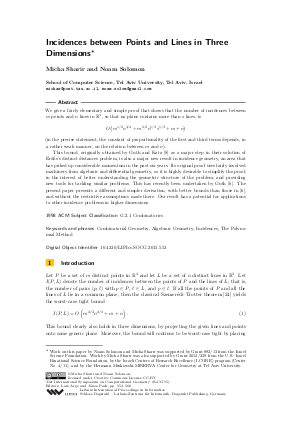Incidences between Points and Lines in Three Dimensions
Authors Micha Sharir, Noam Solomon
-
Part of:
Volume:
31st International Symposium on Computational Geometry (SoCG 2015)
Part of: Series: Leibniz International Proceedings in Informatics (LIPIcs)
Part of: Conference: Symposium on Computational Geometry (SoCG) - License:
 Creative Commons Attribution 3.0 Unported license
Creative Commons Attribution 3.0 Unported license
- Publication Date: 2015-06-12
File

PDF
LIPIcs.SOCG.2015.553.pdf
- Filesize: 0.53 MB
- 16 pages
Document Identifiers
Subject Classification
Keywords
- Combinatorial Geometry
- Algebraic Geometry
- Incidences
- The Polynomial Method
Metrics
- Access Statistics
-
Total Accesses (updated on a weekly basis)
0PDF Downloads0Metadata Views
Abstract
We give a fairly elementary and simple proof that shows that the number of incidences between m points and n lines in R^3, so that no plane contains more than s lines, is O(m^{1/2}n^{3/4} + m^{2/3}n^{1/3}s^{1/3} + m + n) (in the precise statement, the constant of proportionality of the first and third terms depends, in a rather weak manner, on the relation between m and n).
This bound, originally obtained by Guth and Katz as a major step in their solution of Erdos's distinct distances problem, is also a major new result in incidence geometry, an area that has picked up considerable momentum in the past six years. Its original proof uses fairly involved machinery from algebraic and differential geometry, so it is highly desirable to simplify the proof, in the interest of better understanding the geometric structure of the problem, and providing new tools for tackling similar problems. This has recently been undertaken by Guth. The present paper presents a different and simpler derivation, with better bounds than those in Guth, and without the restrictive assumptions made there. Our result has a potential for applications to other incidence problems in higher dimensions.
Cite As Get BibTex
Micha Sharir and Noam Solomon. Incidences between Points and Lines in Three Dimensions. In 31st International Symposium on Computational Geometry (SoCG 2015). Leibniz International Proceedings in Informatics (LIPIcs), Volume 34, pp. 553-568, Schloss Dagstuhl – Leibniz-Zentrum für Informatik (2015)
https://doi.org/10.4230/LIPIcs.SOCG.2015.553
BibTex
@InProceedings{sharir_et_al:LIPIcs.SOCG.2015.553,
author = {Sharir, Micha and Solomon, Noam},
title = {{Incidences between Points and Lines in Three Dimensions}},
booktitle = {31st International Symposium on Computational Geometry (SoCG 2015)},
pages = {553--568},
series = {Leibniz International Proceedings in Informatics (LIPIcs)},
ISBN = {978-3-939897-83-5},
ISSN = {1868-8969},
year = {2015},
volume = {34},
editor = {Arge, Lars and Pach, J\'{a}nos},
publisher = {Schloss Dagstuhl -- Leibniz-Zentrum f{\"u}r Informatik},
address = {Dagstuhl, Germany},
URL = {https://drops.dagstuhl.de/entities/document/10.4230/LIPIcs.SOCG.2015.553},
URN = {urn:nbn:de:0030-drops-51107},
doi = {10.4230/LIPIcs.SOCG.2015.553},
annote = {Keywords: Combinatorial Geometry, Algebraic Geometry, Incidences, The Polynomial Method}
}
